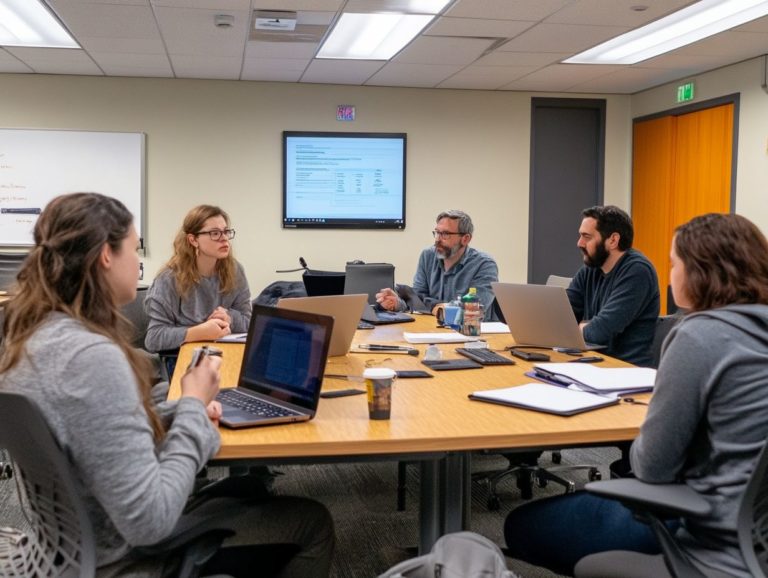How to Make Performance Reviews More Effective
Performance reviews are a key part of cultivating a productive workplace. They offer valuable feedback and lay the groundwork for meaningful development and personal growth.
However, many organizations encounter obstacles in executing these reviews effectively. This article delves into the importance of regular feedback, highlights common pitfalls, and presents proven best practices to enhance the performance review process.
From establishing Specific, Measurable, Achievable, Relevant, and Time-bound (SMART) goals to providing helpful feedback and celebrating achievements, discover strategies to refine your review process and boost employee success.
Contents
- Key Takeaways:
- The Importance of Performance Reviews
- Top Challenges in Performance Reviews and How to Overcome Them
- Best Practices for Conducting Performance Reviews
- How to Set Meaningful Goals and Expectations
- Giving Helpful Feedback
- Celebrate Success: Recognizing and Rewarding Performance!
- Frequently Asked Questions
Key Takeaways:

- Give regular feedback to quickly identify and solve problems.
- Set clear goals and use effective communication to boost growth.
- Motivate employees by recognizing their achievements.
The Importance of Performance Reviews
Performance reviews play a key part in performance management within your organization. They provide a structured platform for meaningful dialogue between managers and employees. This is your chance to discuss employee performance, set goals, and explore pathways for professional growth.
Implementing regular evaluations cultivates a culture of feedback that enhances workplace dynamics. It encourages open conversations and emotional insights that ultimately boost employee engagement and satisfaction. Research from Gallup indicates that organizations that conduct effective performance reviews see notable increases in employee motivation and retention rates.
Why Regular Feedback is Essential
Regular feedback is crucial for your continuous development. It helps pinpoint areas for improvement and align your performance with organizational goals.
This ongoing dialogue clarifies expectations and enables you to take ownership of your growth. Utilizing different feedback systems, such as 360-degree feedback, offers a comprehensive perspective by incorporating insights from peers, managers, and even clients.
Employing various communication styles like one-on-one meetings, peer reviews, and digital platforms can significantly enhance your feedback experience. By fostering a culture that values open communication and encourages helpful feedback, organizations can create an environment where you feel valued and motivated to excel, ultimately driving overall performance and success.
Top Challenges in Performance Reviews and How to Overcome Them
You may encounter several common challenges during performance reviews. These include recognizing biases, delivering criticism effectively, and ensuring the review process itself is truly impactful.
These hurdles can obstruct meaningful conversations about employee performance and growth, ultimately affecting the development of your team.
Identifying and Addressing Issues
Identifying and addressing issues in performance reviews demands open feedback conversations. These invite emotional responses from employees, offering you a clearer understanding of their areas for improvement.
This dialogue paves the way for honesty and enables team members to share their perspectives on the challenges they encounter in their roles.
As a manager, your role in this process is vital. Providing helpful feedback that is both specific and actionable is key. By tuning into the emotions and concerns of your team, you can create an environment where individuals feel genuinely supported and motivated to grow.
Regularly revisiting these discussions ensures that performance issues are not just identified but effectively tackled, enabling both employees and the organization to thrive together.
Best Practices for Conducting Performance Reviews

When conducting performance reviews, embrace best practices that elevate the entire process.
- Utilize tools to assess performance that provide valuable insights.
- Cultivate a robust feedback culture that encourages open dialogue.
- Ensure managers are thoroughly trained in the review process.
By doing so, you create an environment that values employee growth and enhances overall organizational effectiveness.
Preparing for the Review Process
Focus on tracking performance before the review. Set clear goals and adopt effective communication styles to cultivate a productive appraisal environment, utilizing performance reviews best practices and tools.
To maximize effectiveness, gather performance data throughout the evaluation period. Document every achievement and area for improvement meticulously. This practice creates a comprehensive overview of an employee’s contributions and lays a solid foundation for meaningful conversations.
Set specific, measurable, achievable, relevant, and time-bound (SMART) goals to provide clarity and direction. This allows employees to fully grasp what is expected of them. Engage in regular feedback sessions to further support them and pave the way for a more constructive performance review.
Effective Communication Techniques
Effective communication is essential for delivering constructive feedback that aligns employee performance with organizational goals while considering employees’ emotional responses.
Utilize strategies like active listening, where you fully focus on the speaker without interruptions, ensuring you understand any concerns they raise. Incorporate nonverbal cues, such as appropriate body language, to enhance receptiveness to feedback.
Create a safe environment where employees feel valued. This approach helps mitigate emotional reactions during performance discussions. By being mindful of your tone and phrasing, cultivate a positive atmosphere that encourages openness and collaboration, ultimately leading to improved job performance.
How to Set Meaningful Goals and Expectations
Setting meaningful goals and expectations requires utilizing the SMART goal framework. This ensures your objectives are specific, measurable, achievable, relevant, and time-bound, effectively aligning individual performance with the organization’s overarching goals.
By doing so, you create a clear path to success for yourself and the team.
SMART Goal Setting
SMART goal-setting provides a structured approach to defining clear, actionable objectives that enhance performance measurement and employee effectiveness.
This approach includes five key parts: Specific, Measurable, Achievable, Relevant, and Time-bound. Each element is vital in shaping how you establish and pursue your goals.
Specificity guarantees your goals are well-defined and unambiguous, eliminating confusion and sharpening focus. Measurability enables you to track progress effectively, ensuring outcomes can be assessed against established benchmarks.
Achievability ensures your goals are realistic and attainable, fostering motivation rather than frustration. Relevance aligns your goals with broader organizational objectives, creating a sense of purpose that resonates with your employees. Finally, the time-bound nature of these objectives infuses a sense of urgency, prompting timely action and prioritization.
By integrating this SMART framework, you can significantly refine your management practices, leading to enhanced outcomes across various departments.
Giving Helpful Feedback

Providing helpful feedback is crucial for fostering employee development. It s about delivering criticism in a way that encourages positive reinforcement and actively supports the growth of each individual.
This approach aids in their improvement and strengthens the overall team dynamic.
Tips for Providing Helpful Criticism
When delivering helpful criticism, use thoughtful feedback techniques. Consider the emotional responses of your team members while focusing on clear performance standards.
Cultivating a strong relationship with your team significantly enhances the feedback process. By creating a supportive environment, you’re more likely to foster positive engagement with your critiques.
Start by highlighting their strengths. This builds trust and sets a positive tone. It s also important to communicate with empathy, understanding their perspectives and feelings.
Encourage an open dialogue, allowing them to express their thoughts or concerns. This personalizes your feedback and makes it more constructive.
If you frame criticism as an opportunity for growth rather than a reprimand, you pave the way for improved performance and build trust within your team.
Celebrate Success: Recognizing and Rewarding Performance!
Recognizing and rewarding performance is essential for cultivating employee satisfaction. Thoughtful incentives support a positive feedback culture and enhance effective performance tracking.
This approach boosts morale and encourages a high level of engagement among your team.
Incentives and Recognition Strategies
Incentives and recognition strategies elevate employee engagement. Acknowledging individual contributions and aligning them with organizational success creates an environment where everyone feels valued.
These strategies lift morale and create a strong sense of belonging. You can try exciting methods like:
- Monetary bonuses: Tangible rewards that motivate employees.
- Flexible work options: Providing work-life balance and autonomy.
- Public recognition programs: Celebrating achievements in front of peers.
- Opportunities for professional development: Investing in employee growth.
These incentives motivate you to perform at your best and foster a collaborative culture. When you feel appreciated through consistent recognition, your emotional connection to the company deepens, enhancing your job satisfaction.
As a result, you ll likely notice a significant boost in productivity, which creates a win-win situation for both you and the organization.
Frequently Asked Questions
Why are performance reviews important?

Performance reviews are important because they allow employers to provide feedback on their employees’ performance, set goals for improvement, and recognize achievements.
How do I make performance reviews better?
Start by setting clear expectations and goals, providing regular feedback throughout the year, and using specific criteria to evaluate performance.
What should I include in a performance review?
A performance review should summarize the employee’s job responsibilities, their progress towards goals, feedback on performance, and a plan for improvement and development.
How often should performance reviews be conducted?
Performance reviews should occur at least once a year. Ideally, conduct them quarterly or bi-annually for timely feedback and adjustments.
How can I make performance reviews more collaborative?
Involve your employees by giving them the opportunity to self-evaluate, share their thoughts, and discuss their performance and goals.
For more tips on implementing these strategies, feel free to reach out!
How do I handle difficult conversations during a performance review?
Facing tough talks during performance reviews can be challenging. Approach these discussions with empathy to create a supportive atmosphere.
Stay focused on specific actions and behaviors. Offer constructive feedback along with practical solutions to help improve performance.





